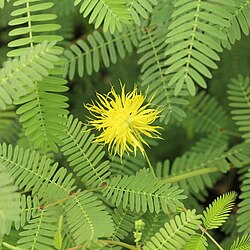Neptunia oleracea
Species of flowering plant From Wikipedia, the free encyclopedia
Neptunia oleracea, commonly known in English as water mimosa or sensitive neptunia, is pantropical nitrogen-fixing perennial legume. Genus and common name come from Neptune, god of the sea, in reference to the aquatic habit of some species in the genus.
This article needs additional citations for verification. (March 2013) |
| Neptunia oleracea | |
|---|---|
 | |
 | |
| Scientific classification | |
| Kingdom: | Plantae |
| Clade: | Tracheophytes |
| Clade: | Angiosperms |
| Clade: | Eudicots |
| Clade: | Rosids |
| Order: | Fabales |
| Family: | Fabaceae |
| Subfamily: | Caesalpinioideae |
| Clade: | Mimosoid clade |
| Genus: | Neptunia |
| Species: | N. oleracea |
| Binomial name | |
| Neptunia oleracea Lour. | |
| Synonyms | |
| |
Its specific epithet oleracea means "vegetable/herbal" in Latin and is a form of holeraceus (oleraceus).[1][2]
Description
Aerenchyma (white spongy air-conducting tissue that gives stems buoyancy) forms on stems floating in water, but does not form on stems growing on land. Plants typically grow to as much as 6" tall, but stems will spread in the water to 3-5' long. Stems are clad with bi-pinnate, fine, mimosa-like sensitive leaves that close up when touched. Primary leaf segments have 8-40 small oblong leaflets arranged in opposite pairs. Tiny greenish-yellow flowers are densely crowded into feathery orbicular inflorescences that bloom in summer. Fruits are flat pods (to 1-2" long). Floating aquatic plant stems often form thick foliage mats and is considered to be an invasive aquatic weed in some tropical waters where large mats may form that choke waterways, resulting in restricted water flow, reduced water quality, reduced fish activity and loss of some underwater and native wetland plants.
Habitat
Primarily found growing prostrate in wet soils near the water's edge or floating on the water in relatively still-water areas.
Uses
Culinary
This plant is cultivated as a vegetable in southeast Asia (leaves and shoots have cabbage-like flavor). Young ends of stems and pods are edible and usually eaten raw as a vegetable in Vietnam, Thailand, Laos and Cambodia and cultivated much like rice. The young leaves, shoot tips and young pods are usually eaten raw or in stir-fries and curries such as kaeng som.[3]
- Yam phak krachet, a Thai salad made with cooked water mimosa
- Lao-style green papaya salad (left) served with raw sprigs of water mimosa (right)
Medicinal
Juice of the stem and roots are used for medicinal purposes. Whole plant extract exhibited cytotoxic activity on neoplastic cell lines[citation needed]. Extract of the herb exhibited hepatoprotective activity[citation needed].
Common names
- Khmer: Kanchait (កញ្ឆែត)
- Meiteilon/Manipuri: Eshing ekai thabi
- Thai: Phak runon (ผักรู้นอน) or phak krachet (ผักกระเฉด), pronounced "phak kachēt".[4]
- Vietnamese: Rau nhút
- Sinhalese: දිය නිදිකුම්බා
- Tamil language: Cuṇṭi or nīrc-cuṇṭi,[5] referring to its sensitivity to touch (cuṇṭu: to tap with thumb or finger)[6]
- Mon: Khamək (ခမက်)
References
External links
Wikiwand - on
Seamless Wikipedia browsing. On steroids.


